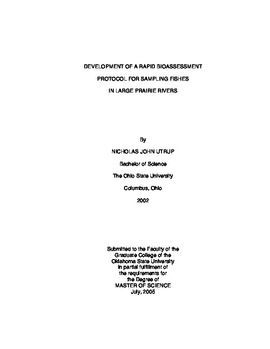| dc.contributor.author | Utrup, Nicholas John | |
| dc.date.accessioned | 2014-04-17T20:13:19Z | |
| dc.date.available | 2014-04-17T20:13:19Z | |
| dc.date.issued | 2005-07-01 | |
| dc.identifier.uri | https://hdl.handle.net/11244/10326 | |
| dc.description.abstract | Assessment of the biotic integrity of large rivers depends on efficient and statistically-sound procedures for sampling. Large prairie rivers in the Great Plains ecoregion pose a unique challenge for sampling because their physical and chemical properties limit the types of gear, such as electrofishing, that are traditionally used to sample fish for bioassessments. In this study, I used seining and hoop netting to collect fishes at 15 sites in five large prairie rivers in Oklahoma to (1) determine the minimum amount of effort needed to detect the majority of fish species at a sample site and (2) examine the selectivity of fish species detected by the two gear types. Based on my findings, I present recommendations for sampling fish assemblages in large prairie rivers. Analysis of similarities of the fishes collected in six different habitat types identified two distinct habitat types based on fish species composition: shallow/backwater (SBW) habitat (depth < 0.75 m) and deep/non-wadeable (DNW) habitat (depth > 0.75 m). I estimated that eight SBW habitats and four DNW habitats at each sample site were needed to detect a majority of fish species during a sampling event. Minimum sampling distance needed to encounter the required number of habitats ranged from 400 m to 1600 m and averaged 887 m. Gear evaluation showed seining captured more species-per-unit-effort than hoop netting (3.6 and 1.4 respectively); however, hoop netting captured significantly larger fish (527 mm; P < 0.001) than seining (42 mm). Based on these results I recommend the following protocol for sampling fish assemblages in large prairie rivers: (1) use aerial photos to determine site accessibility and sampling distance prior to leaving for the field, (2) sample a minimum of eight randomly selected SBW habitats using a seine, and (3) set a minimum of two hoop nets per DNW habitat. With some modifications these recommendations can be applied to similar rivers throughout the Great Plains to aid in the rapid bioassessment and monitoring of fish assemblages in large prairie rivers. | |
| dc.format | application/pdf | |
| dc.language | en_US | |
| dc.publisher | Oklahoma State University | |
| dc.rights | Copyright is held by the author who has granted the Oklahoma State University Library the non-exclusive right to share this material in its institutional repository. Contact Digital Library Services at lib-dls@okstate.edu or 405-744-9161 for the permission policy on the use, reproduction or distribution of this material. | |
| dc.title | Development of a Rapid Bioassessment Protocol for Sampling Fishes in Large Prairie Rivers | |
| dc.type | text | |
| osu.filename | Utrup_okstate_0664M_1405.pdf | |
| osu.college | Arts and Sciences | |
| osu.accesstype | Open Access | |
| dc.description.department | Wildlife Ecology | |
| dc.type.genre | Thesis | |
